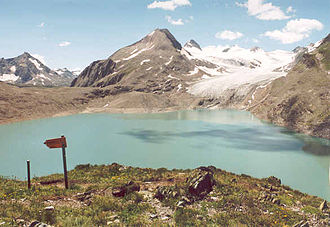Griespass
| Griespass | |||
|---|---|---|---|
|
View over the Griessee to the south to the Griespass and Griesgletscher |
|||
| Compass direction | north | south | |
| Pass height | 2479 m above sea level M. | ||
| region | Canton of Valais | Verbano-Cusio-Ossola Province | |
| Watershed | Aegine | Toce | |
| Valley locations | Ulrichen | Formazza | |
| expansion | Mule track | ||
| Mountains | Alps | ||
| Map (Valais) | |||
|
|
|||
| Coordinates , ( CH ) | 46 ° 27 '14 " N , 8 ° 22' 26" O ( 671 854 / 145156 ) | ||
The Griespass (Italian Passo del Gries ) is a mule pass that leads over the southern main ridge of the Alps . The pass height is at 2479 m above sea level. M.
geography
The border between Italy and Switzerland runs over the Griespass, near the Nufenenpass . The Griespass represents a transition from the Valais Aegin Valley into the Italian Val Formazza (German Pomatt ) and thus connects the Goms with the Valle d'Ossola . It is flanked in the west by the Bättelmatthorn (Italian Punta dei Camosci , 3,044 m ) and in the east by the Grieshorn (Italian Corno Gries ).
The dammed Griessee , which is fed by the Gries Glacier , is located on the Swiss side just below the top of the pass . The glacier reached down to the Griessee until around 2001. This is where the Gries wind farm is located, the tallest wind power plant in Europe built in 2011 . On the southern side in Italy lies the Alp Bättelmatt, then the reservoir Lago di Morasco (German Muraschgsee ) and the hamlet Riale (wdt. Cherbäch ).
history
Since the Griespass does not offer any topographical difficulties on either side, it was already known in the Bronze Age and was also used extensively in Roman times. In the 13th century, the Walsers migrated from Upper Valais over the pass into Pomatt and founded villages there, where Walser German is still spoken today. The Griespass forms the straight southern continuation of the Grimselpass and was therefore one of the few easily accessible and direct routes from the north side of the Alps to Italy.
From 1397 the mule track was expanded as a transalpine trade route. However, the old federal possessions in Ashenvale were lost to the Duchy of Milan as early as 1422 , so that trade quickly declined and in the following centuries only had regional importance. When the Gotthard Railway opened in 1882, it finally came to a standstill. On the Italian side of the top of the pass there is also a chapel that doubles as a bivouac (box). The bivouac was extensively renovated in 2014 and equipped with solar power.
Richard Wagner crossed the Griespass with his mountain guide on July 18, 1852 on his trip to Italy.
The gas pipeline of the Swiss company Transitgas AG , which is invisible because it runs underground, is of international importance and ran over the Griespass between 1971 and 1974 with an inner diameter of 34 inches . On the Swiss side, the pipeline runs in 5 tunnels, each equipped with a funicular . In the years 1997 to 2003 the capacity was increased and the pipeline on the Swiss side of the Griespass was replaced by a 48 "gas pipeline. The gas pipeline carries gas from the Netherlands to Italy.
literature
- Klaus Aerni: Griespass. In: Historical Lexicon of Switzerland . 4th May 2017 .
Web links
- Griespass on the ETHorama platform
Individual evidence
- ^ Club Alpino Italiano (CAI): Bollettino CAI Milano - LG_marzo 2014. CAI Milano, accessed on October 4, 2019 (Italian).
- ^ Wagner, Richard: My life . In: Hofenberg Collection . tape 1 - 4 . Publishing house of Contumax GmbH & Co. KG, Berlin, Berlin 2015, ISBN 978-3-8430-2104-3 , p. 919 .
- ↑ Our story transitgas.org, accessed October 8, 2018.


